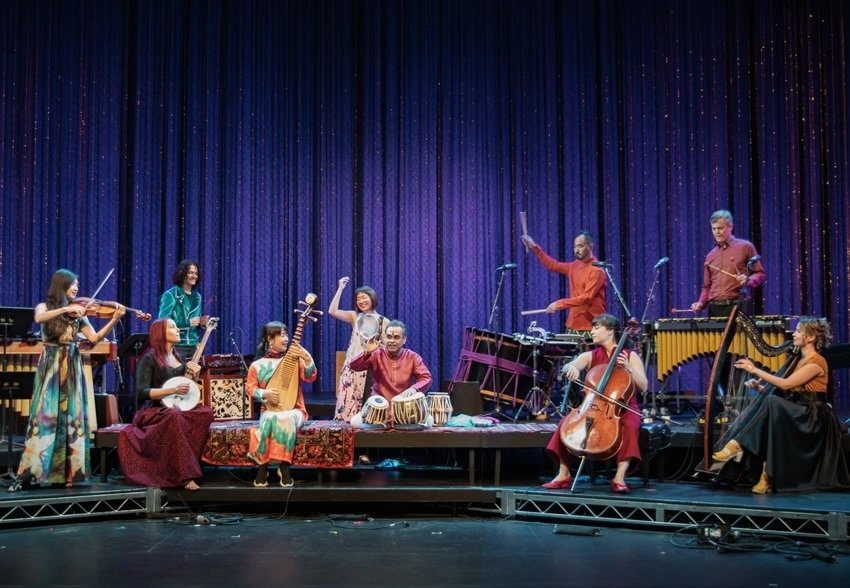The Silkroad Ensemble with Rhiannon Giddens' American Railroad Really Is A Musical Journey of Reclamation
This article was published by Triangle Review on 21 November 2024.
"I'm not expecting much," my 14-year-old cellist son said as we drove through Wednesday night's rain to the University of North Carolina at Chapel Hill's Memorial Hall to see the Carolina Performing Arts' presentation of American Railroad: A Musical Journey of Reclamation, the Silkroad Ensemble's latest social-justice journey through music.
"I'm not either," I lied, though I knew next to nothing about what we were going to see.
On a big movie screen behind the performers, audience members were treated to a short audiovisual presentation about the history of Silkroad and the creation of American Railroad.
Yo-Yo Ma conceived the Silkroad ensemble in 1998, bringing together musicians from the lands of the ancient Eurasian Silk Road in a model of cultural collaboration.
Today, Silkroad is under the leadership of artistic director Rhiannon Giddens, a remarkable musician and social-justice advocate whose many honors include two Grammy awards, a Pulitzer Prize, and a MacArthur "Genius" grant. NPR has named her one of its 25 Most Influential Women Musicians of the 21st Century, and American Songwriter calls her "one of the most important musical minds currently walking the planet."
Silkroad’s latest project, American Railroad depicts the generally overlooked impact of thousands of Indigenous, African, Chinese, Japanese, Irish, and other immigrants on the astonishing construction of the U.S. Transcontinental Railroad and connecting railways in North America.
Silkroad musicians visited, held workshops, and learned the generational histories and musical influences of many of the areas pictured on the giant screen behind the performers as they play, rendering the powerful images mere introductions to the musical stories emanating beneath them.
American Railroad's journey begins with indigenous singer-songwriter Pura Fe's soulful chanting in "Swannanoa Tunnel/Great Grandpa's Banjo." The rest of the ensemble joins her in a musical experience imbued with Native American tradition, as images of the American Frontier dissipate into photos of African-American railroad construction workers.
The journey proceeds to the Chinese-influenced "Tamping Song," featuring Japanese percussionist Kaoru Watanabe with intermittent photos of mountain scenes and Chinamen in conical hats, working along the American railroad.
Next is "Swannanoa Tunnel/Steel-Driving Man," in which -- against a backdrop of photos, including black teenage railroad workers in prison uniforms -- Rhiannon Giddens pays siren-like, African-American-infused musical tribute to the more than 1,200 men who died while constructing the Transcontinental Railroad.
This is followed by "Far Down Far", a dramatic orchestral- and fiddle-infused embodiment of the experience of Irish railroad workers, in their paddy caps and wool, who "took the jobs nobody else wanted."
Additional songs feature the influences of India and Central Asia on the railroad boon, using combinations of classical, modern, and just plain unique musical styles. Highlights are Balla Kouyate's vigorously accurate solos on the balafon; Maeve Gilchrist's complicated celtic harp melodies; Mike Block's standing cello gymnastics; Yazhi Guo's mastery of the suona, hulusi, and guanzi (traditional Chinese instruments); Sandeep Das' performance on the tabla (Indian hand drums); the multifaceted prowess of Francesco Turrisi (frame drums, accordion); and Shane Shanahan's mastery of the Jew's harp.
At two hours long with an additional 20-minute intermission, an evening performance of Silkroad's American Railroad is not for the faint hearted. But you will only benefit from this passionately auditory reflection on those nameless souls who have contributed (and continue to do so) to the freedom and convenience enjoyed in America.
.
As if my son and I weren't impressed enough, while perusing the giant memorial tablets along the walls of Memorial Hall (originally built in 1885 to honor Civil War veterans and university figures), we came upon Calvin Graves, the white Confederate North Carolina legislator who "gave the casting vote for building the North Carolina Railroad and lifted the first spade of Earth to its bed."
Who could ask for a more synchronous ending to our "Musical Journey of Reclamation"?
.


